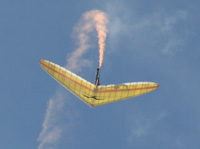EARN YOUR RADIO LICENSE IN ONE DAY!
Saturday, November 3, 2007
8:45AM SHARP! - 3:00PM
San Francisco County Fair Building Hall of Flowers – Rec Room
9th Avenue and Lincoln Way
There will be a General cram for Techs same place & time.
Ample free parking. Great lunch restaurants nearby.
Bring 2 IDs (one with picture), a pencil and
$20 cash for Technician study materials and test OR
$40 cash for General study materials, lecture and test OR
$14 cash for testing only (general, extra, Morse tests available too)
8:45AM Study checkin, Don’t be late. Drop ins OK. Test only 2PM.
8:50 Beginners’ tips
9:00 Self-study starts
1:30 Exams begin
No advance preparation needed for beginners, we do it all in 6 hours. General exam class at 9:15AM (if you are already licensed).
Questions? hamcrams.com Next test date January, 2008
Passing this test will get you a ham radio license from the FCC good for 10 years. You will be able to use:
O local repeaters for Bay Area communication
O Echolink for Internet-based radio
O satellite and moon-bounce
O international shortwave frequencies for global communication!
Come and join the great world-wide community of ham radio.
Sponsors/supporters: UPDATED: 5-22-2007
Auxiliary Emergency Radio Organization (AERO)
Bay Area Red Cross
Salvation Army more info follows W5YI-VEC
Important news on Upgrading to GENERAL: If you now hold a Technician license and you would like GENERAL privileges you need to pass Element 3 of the test. You will not be required to learn Morse code any more to get a general license. If you have a CSCE (certificate) giving you credit for Element 3 which is less than one year old on the date you present it, simply bring it to any test session of ours at 11AM or 2PM. You will need to register for the session ($14) and fill out a form. Be sure to bring the original AND a copy of your CSCE. If you now hold a Technician license but haven’t passed Element 3 yet, come to any session with a copy and the original of your license and take our GENERAL cram ($40, includes class, study guide, and testing). It’s essential you first refresh your high school physics material on waves and the relationship between wave-length, frequency and voltage, plus current, resistance, capacitance and inductance, and power (the electricity chapter, DC and AC).
How our cramming system works: John Portune, W6NBC, discovered and Ross Patterson developed and perfected a technique based on the fact that short term memory was a fantastic aid for retaining answers to test questions for an hour or two. From this Ross devised the famous “ham cram” (rapid scanning of questions and answers for just a few hours, then sitting down and taking the test). His method has consistently achieved pass rates of 75-95%.
This method does NOT teach you how to be a radio operator, or even the material which underlies the test questions. This method focuses on your PASSING the test. This is Step 1 in becoming a ham radio operator.
Step 2 is to buy a radio, and Step 3 is to learn how to use it. We sell an inexpensive book to help with Step 3 right after the exam. Step 4 is to get on the air, and get experience checking into nets that are used for preparedness and drill. As you progress in Step 4, you may wish to serve as net control for a net some evening.
But first things first–get your license. And that is what this day’s activities are all about. Because the test focuses on SHORT TERM memory, there is little purpose in getting the technician test materials in advance.
Study tips: If you want to do some advance preparation, get hold of a high-school physics book and read the part about the relationship between wavelength and frequency and the relationship between current, voltage, resistance and power.
Or: Wavelength x Frequency = Velocity
For radio waves, we use the velocity of light, 300 million meters per second. If we measure frequency in Megahertz (1 million cycles per second), then the formula becomes meters x megahertz= 300. So if I ask you what is the wavelength of a 150 Megahertz signal, the answer is 2m. If you need to convert meters to feet, multiply by 3 and add 10%. A half-wave antenna has one-half wavelength elements. A conventional dipole has 1/4 wavelength elements.
Current (rate of flow) = amperes (amps) = I
Voltage (pressure) = volts = EMF = E (for electromotive force)
Resistance = ohms = R I=E/R
Power = watts = P P=I x E
EARN YOUR HAM RADIO LICENSE IN ONE DAY!
3 posts
• Page 1 of 1
-

Steve Rodrigues - Site Admin
- Posts: 723
- Joined: Mon May 24, 2004 10:57 pm
- Location: Brisbane, California
Steve, sounds interesting - but can you tell me, briefly: if I already have the Technician class license, what are the additional advantages / privileges / etc that come along with stepping up to General class? Does this have any specific relevance to folks who mainly use ham radio in connection with flying?
- Matt
- Matt
- Matt
All one needs to operate on 2 meter frequencies commonly used for HG is the Technician class license.
If you have interest in expanding your hobby as a HAM operator, General class gives privileges on different frequencies etc.
If you have interest in expanding your hobby as a HAM operator, General class gives privileges on different frequencies etc.
-

Steve Rodrigues - Site Admin
- Posts: 723
- Joined: Mon May 24, 2004 10:57 pm
- Location: Brisbane, California
3 posts
• Page 1 of 1
Who is online
Users browsing this forum: No registered users and 8 guests
